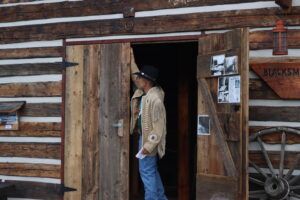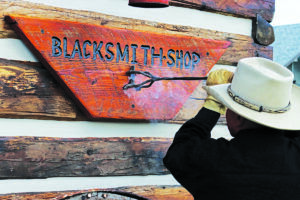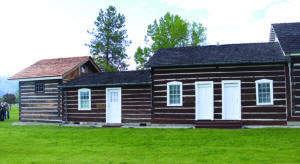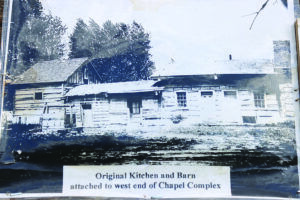
by John Dowd
Two years ago, the Historic St. Mary’s Mission broke ground on a project reconstructing the blacksmith shop that originally stood attached to the back of the mission. The project was completed one piece at a time, as funding allowed, since funding was the largest hurdle for the undertaking. Chris Weatherly, the person responsible for the majority of the work, explained he may have come close to going over the budget several times. However, according to Colleen Meyer, the money often came when they needed it the most. “It’s a God thing,” said Meyer.
Meyer was the executive director of Historic St. Mary’s Mission prior to Dora Bradt, who holds that title today. As Meyer was director until 2021, she was also involved with the first discussions to recreate a model of the blacksmith shop. According to Meyer, the idea of doing so seemed a far out prospect, and they “figured it would take even five years,” or more to finish. They also decided the best approach to combat the intermittent funding flow would be to pay as they went, which would contribute to the long haul. However, just “over a short two years, here we are,” said Meyer.

To celebrate the finalization and public opening of the blacksmith shop, the mission held a dedication ceremony last Tuesday, May 30. The event was also meant to honor the man that built the shop, Chris Weatherly. According to Meyer, “Everything from the foundation up has Chris’s handprints.”
For Weatherly, who has helped with numerous restorations and reconstructions across both Montana, and sites back east, it is all about the history. “I appreciate what the people that came before me could do,” said Weatherly. “It’s my job to carry it on.”
When asked about his love for history, he referenced his youth. Having grown up east of the Mississippi, he was surrounded by the footsteps of founding fathers and old structures where history runs very deep. He explained that, whether it is the history of native peoples, or those of the Europeans that colonized the lands, he often gets “goosebumps” when doing things like pulling the nails out of old structures. For him, the feeling seems to emanate from those men that put them there, and he often feels that he hears their words speaking to him as he too tries to imitate the work they mastered back in the day.
“I can’t get enough history,” said Weatherly, who spoke in the rebuilt blacksmith shop. The new structure was built using period timbers from another building in Dillon. According to Weatherly, there was a lot of discussion that went into whether they should use modern logs and make them look old or to find old logs and hew them into shape. According to him, it was a clever shortcut to use other period timbers that would already have the aged look. This would also allow him to skip the long and laborious task of hewing the logs, meaning to take them from round and cut them into square beams. “I wanted to make it look like it’s been here over 100 years,” said Chris about his efforts. According to many in attendance at the dedication ceremony who were not aware of the full scope of the project, the new building matches up so well that they assumed it was only the inside that had been remodeled.

The new blacksmith shop was constructed over its progenitor’s original position, attached to the back of the kitchen, which in turn is attached to the back of the mission.
The shop includes artifacts that were excavated from the ground under the shop foundation, as well as period tools and devices one might have seen in a similar shop of the time. Some of the artifacts recovered include what is believed to be metal slag from the forge and the top of a large wood stove that was probably used to heat the original shop. Chris theorizes that it may have been that stove that caught the original building on fire.

According to Weatherly, the fire in 1908 burned both the blacksmith shop and the kitchen, completely destroying the shop. The kitchen was restored in 1991, and now, finally, the blacksmith shop as well. According to Weatherly, “Most people don’t know it, but this area is chock full of history.” Weatherly said this, speaking about the iconic and important early history of Montana, which has strong roots in the Bitterroot Valley.
For those interested in learning more about the process in recreating the shop, or about early history of the shop and the area, there is an upcoming event that may be of interest. Weatherly has been asked to speak at the museum in Victor about the process. He will be presenting July 11, starting at 6:30 p.m. at the Victor Heritage Museum.
According to Bradt, who spoke during the Blacksmith’s Shop Dedication Ceremony, “This mission is not just our responsibility, it is the town’s, it is the state’s. It is our duty to preserve it and to admire it.” She thanked Weatherly, who put so much work into resurrecting the building in its original place, as a location for visitors to learn about the early history of Montana, and to see what it may have looked like. The new blacksmith shop is now part of the tours done at the mission, for anyone interested in visiting it.
During the ceremony, it was announced that the shop is being dedicated to Weatherly. For more information about the St. Mary’s Blacksmith Shop, or to schedule a tour of the mission grounds, interested parties can visit saintmarysmission.org, or call (406) 777-5734.
